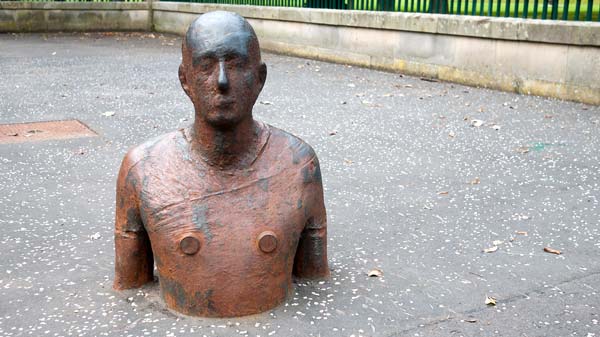
A Short Walk To The Gallery
Here in the west end of Edinburgh where we are staying during the Edinburgh Festival, it is only a short walk to the Scottish National Gallery Of Modern Art.
This statue by Antony Gormley of a man half underground is at the pedestrian entrance to the gallery.
Or rather, it is at the pedestrian entrance to half of the gallery.That is because the gallery is in two halves.
Each half of the gallery is housed in a grand building set in its own grounds with the two galleries separated by a road.
The first time we visited – by car – we dithered whether to turn left into one half of the gallery or right into the other half.
I am sure there is the germ of an idea there for a new gallery exhibit – a video of visitors nonplussed in the middle of the road, lights winking in indecision.
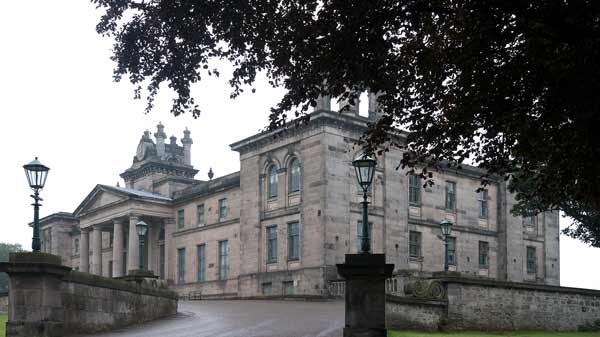
One half of the Scottish National Gallery Of Modern Art was formerly known as the Dean Gallery. It’s name was very recently changed to Gallery Two, but there are still ‘Dean Gallery’ signs everywhere (more confusion).
Those Cold, Clammy Staircases
Gallery Two or The Dean Gallery is a former orphanage, and the staircases at either end of the building are dark and clammy with stone-cold steps and iron railings.
Because of that, I can’t help but wonder what the building felt like to the children to whom it was home before the building was transformed into a gallery and filled with art.
The gallery is home to a fine collection of woodblock prints including a number of prints by the Japanese artist, Hiroshige.
I used to own a book entitled Masters Of The Japanese Print (I wonder where that has gone?) that contained reproductions of some Hiroshige prints. I remember that I spent hours in my teens looking at the color reproductions in the book.
Now, seeing the large prints, I am struck by what a great graphic artist and realist Hiroshige was.
He places people, boats, and bridges half in and half out of the frame – capturing what is within the frame but alluding to what is outside the frame – so that we feel like we are seeing slices of the everyday life that he wanted to capture.
Ian Cheyne
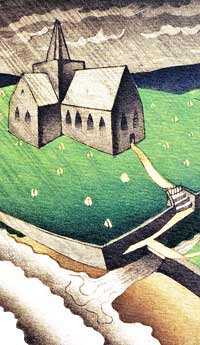
There are also some wonderful woodblock prints by Scottish artists including some by Ian Cheyne – an artist who studied at the Glasgow School of Art.
He used exaggerated perspective to describe dramatic scenes of small figures going about their lives against a backdrop of towering cliffs and crashing waves.
Cheyne died in 1955 and his work was barely known until someone was researching local artists and found his work in the archives of the gallery.
Woodblock Prints
There is a display in the print room showing the stages in the making of a woodblock print – with several woodblocks and semi-finished prints.
I didn’t know before seeing this that some print makers use one block with all the elements cut into it, and make several passes with whatever colors they are using.
Other print makers, however, use several blocks. Each block has part of the image cut into it and each block is colored separately.
I can’t get over the skill and mental agility needed to cut several blocks so that together they make a complete image.
The display is a great introduction to the technique of woodblock printing and well worth seeing.
The Other Half Of The Scottish National Gallery Of Modern Art
The other half the Scottish National Gallery Of Modern Art has the sculpted grounds that you can see in this photograph. The swirling mounds are an art installation designed by Charles Jencks, an American landscape designer.
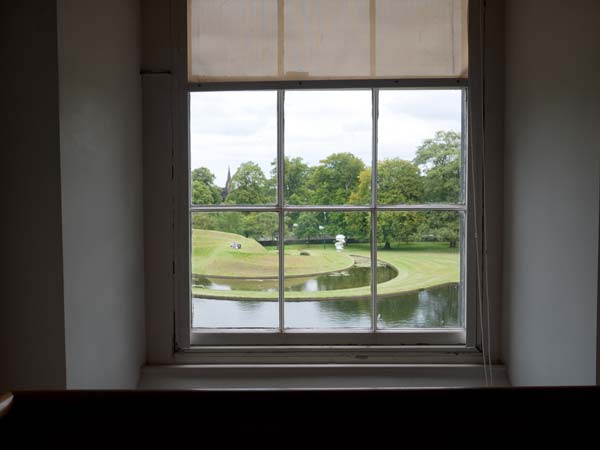
Inside, the gallery houses paintings by Utrillo, Miro, Picasso, Leger, Gaugin, and Wyndham Lewis as well as more recent, how shall I call them, conceptual daubs on canvas.
Gaugin
The Gaugin painting is very interesting. It shows three Tahitian islanders, a young man and two women. They are close up and fill the frame. One is turned away, one half turned and the third is facing to the front.
Until recently, I didn’t take to Gaugin’s work. Slowly though since seeing a huge exhibition of his work in London last year, I have started to appreciate him.
One thing I learned at the London exhibition was how he had held down a responsible job for many years and that he had only gone to Tahiti after his wife demanded that he leave for failing to uphold the values she held dear.
I am sure the story is more complicated that that, but understanding that Gaugin tried to fit in and couldn’t, makes me understand his paintings differently.
Gaugin hated what had happened to Tahiti. He went there expecting a natural island paradise and felt that bureaucracy and Christianity had ruined the place. He railed against the authorities and ended up a drunk and quixotic figure in the eyes of those against whom he battled.
Utrillo
The Utrillo painting is of a lonely little Qquare – maybe in Paris – with the trees bare with their branches sticking up in the characteristic way of many of his paintings. Again, the perspective got to me – with a lot of flattened foreground road and pavement leading to the Square.
Edinburgh And Modern Art
It’s not only the Scottish National Gallery Of Modern Art that has modern art in it.
The Scottish National Gallery just off Princes Street in the center of Edinburgh has two or three rooms of the Impressionists and Post-Impressionists. There is a wonderful Cezanne there called ‘The Trees’ that he painted towards the end of his life.
There are also paintings from much earlier periods, but there is obviously some overlap with the Gallery Of Modern Art. So if you are interested in the art of before and around the turn of the 20th century, then you will want to make time to visit both the Scottish National Gallery Of Modern Art in the west of the city and the Scottish National Gallery off Princes Street in the center of Edinburgh.
Art Lovers
I couldn’t in all honesty say that the galleries in Edinburgh are world-ranking like the National Gallery in London or the National Gallery of Art in Washington D.C., but they are worth a long visit – and because we are staying so close to them, I have been four or five times in the time we have been here in Edinburgh.
The Waters Of Leith
Around the back of this building – behind the garden cafe and the car park – there is a path that leads down through the trees to the Waters Of Leith.
The Waters Of Leith is the name given to the river that wends its way through Edinburgh until it reaches the sea at the Firth Of Forth north of the city.
And standing in the river down below the gallery is this statue by Antony Gormley.
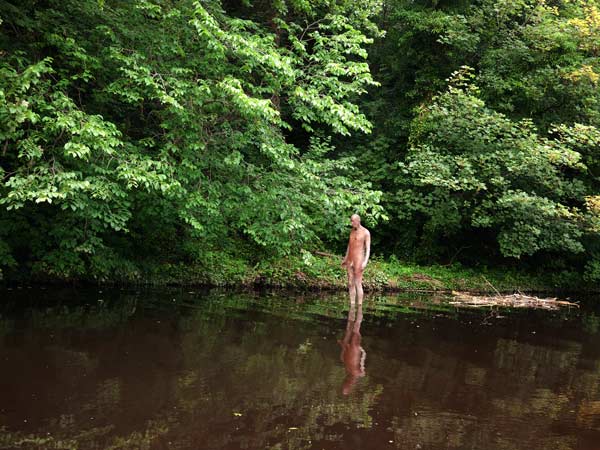
Antony Gormley
Antony Gormley also made the world-famous Angel Of The North sculpture that towers over and dominates the A1 road that connects the north and the south of England. You can read more about the North here.
The Little Wooden Bridge
A little wooden bridge spans the river behind the gallery, and I managed to photograph these two little dogs as they came across it.
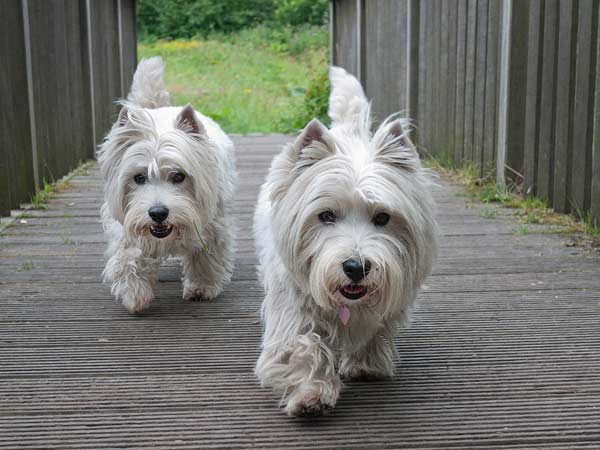
That would have been a couple of days before the heavens opened and a normal August’s worth of Edinburgh rain fell in two days. I shot this short video, with the gentle Waters Of Leith now running fast.